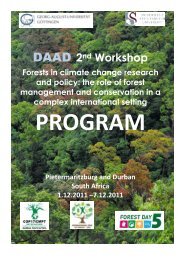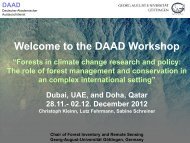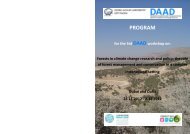Proceedings of the Workshop - Georg-August-Universität Göttingen
Proceedings of the Workshop - Georg-August-Universität Göttingen
Proceedings of the Workshop - Georg-August-Universität Göttingen
You also want an ePaper? Increase the reach of your titles
YUMPU automatically turns print PDFs into web optimized ePapers that Google loves.
Today <strong>the</strong> hacienda has a lease contract with Madeflex S.A. (a wood production<br />
company) which dates January 2000 and has a legal bind <strong>of</strong> agreement <strong>of</strong> 13 years.<br />
This gives <strong>the</strong> University a framework <strong>of</strong> 2 years for preparing new activities and<br />
research projects that are going to take place in <strong>the</strong> hacienda (UdeA 2002).<br />
The predominant ecosystem in this region is tropical dry forest (TDF) within an<br />
area, which has a monomodal regime and an average precipitation <strong>of</strong> 1511 mm/year,<br />
an average temperature <strong>of</strong> 28 °C, and an evaporation average <strong>of</strong> 1754 mm mm/year<br />
(Marulanda, et al. 2003). There are many definitions <strong>of</strong> what constitutes a TDF, one <strong>of</strong><br />
<strong>the</strong> main characteristics <strong>of</strong> this ecosystem is water stress presented by a pronounced<br />
dry season with little or no precipitation (Mendoza 1999), having plant formations which<br />
are featured between 0 – 1000 m above sea level, presenting an average annual<br />
temperature higher than 17 ° C, with annual precipitation levels between 600 and 1800<br />
mm, and two dry periods per year, usually one <strong>of</strong> <strong>the</strong>m long and <strong>the</strong> o<strong>the</strong>r one short<br />
(Murphy & Lugo 1986).<br />
When referring to deforestation in Latin America and <strong>the</strong> Caribbean, <strong>the</strong> focus is<br />
usually in areas <strong>of</strong> tropical and subtropical rainforests, forgetting that <strong>the</strong> losses can be<br />
<strong>of</strong> equal or greater magnitude in <strong>the</strong> TDF (Miles, et al. 2006). The dry forests have<br />
received much less attention regarding scientific and conservation supervision<br />
compared to rain forests (Prance, 2006), but indeed, many authors refer to this<br />
ecosystem, as one <strong>of</strong> <strong>the</strong> most threatened in <strong>the</strong> Neotropics (Linares & Fandino 2009).<br />
In Latin America, approximately 66% <strong>of</strong> TDFs have been destroyed (Quesada, et<br />
al. 2009) and about 97% <strong>of</strong> <strong>the</strong> TDFs are threatened by destruction (Rangel, 2009).<br />
Despite <strong>the</strong>ir high levels <strong>of</strong> endemism and diversity <strong>of</strong> species, TDFs are poorly<br />
protected (Pennington, et al. 2006). It is estimated that area <strong>of</strong> dry sub-humid tropical<br />
forests amounted to 80000 km 2 in 1950, and today only to 1200 km 2 , 1.5% <strong>of</strong> its<br />
original extent, constituting <strong>the</strong> most heavily degraded biome in Colombia (Etter 1993;<br />
Echeverry & Rodriguez 2006; Rangel 2009). Public academic institutions in countries<br />
like Colombia do not have <strong>the</strong> possibility to invest in <strong>the</strong> development <strong>of</strong> projects for<br />
human communities, such as this one. Within this framework, <strong>the</strong> restoration <strong>of</strong> a TDF<br />
is a critical concern, and a very pertinent line <strong>of</strong> work and research.<br />
The University is now interested in supporting projects that aim for biodiversity<br />
conservation in its farms, with environmental and social impacts for communities<br />
articulated with <strong>the</strong> land. In this context, <strong>the</strong> hacienda San Sebastian is a perfect<br />
setting for <strong>the</strong> development <strong>of</strong> a restoration <strong>of</strong> this type in this TDF ecosystem. This is<br />
<strong>the</strong> reason why this multipurpose-program intends to propose a protocol for forest<br />
restoration, conservation, and sustainable use <strong>of</strong> <strong>the</strong> biodiversity <strong>of</strong> <strong>the</strong> TDF that can<br />
be transferred and applied in o<strong>the</strong>r places in Colombia with similar environmental and<br />
social conditions.<br />
2. Material & Methods<br />
2.1. Study area location<br />
The project will be located in <strong>the</strong> municipalities <strong>of</strong> San Sebastián, San Zenon,<br />
Santana and Pijiño del Carmen in south <strong>of</strong> <strong>the</strong> Department <strong>of</strong> Magdalena 74° 21´ W<br />
and 9° 15´ N (figure 1), on <strong>the</strong> right bank <strong>of</strong> <strong>the</strong> Magdalena River, about thirty minutes<br />
from <strong>the</strong> city <strong>of</strong> Mompóx and in total includes some 4,400 hectares. The land is<br />
composed <strong>of</strong> three farms that were donated to <strong>the</strong> university in <strong>the</strong> mid-nineties and<br />
are called: Los Álamos, Terranova y Nueva Esperanza that are subdivided into El<br />
Porvenir, El Enredo, Villa Cata, La Infancia, El Paujil, Guineo Abajo, Sal si puedes, El<br />
96 o Vuelta de los terneros.<br />
‐ 44 -










